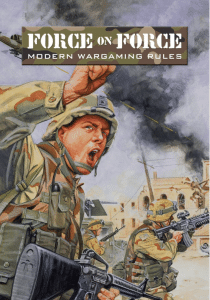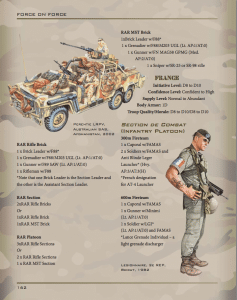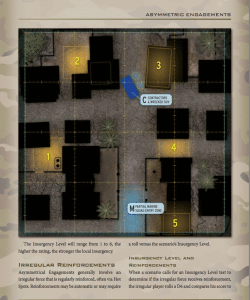Review: Force on Force from Ambush Alley Games and Osprey Publishing
From the outset, let me make clear that I am not a “miniature” guy. Sure, I throw down miniatures for RPG games and “Wing of War,” but I am not someone that sits around painting Napoleanic
Which brings me to “Force on Force:Modern Wargaming Rules” from Ambush Alley Games and Osprey Publishing. This is a hardbound rulebook of 220 glossy pages. Book printing quality is excellent and Osprey provided much of the art. If you a familiar with the Osprey line this is good news. Osprey has some of the most consistent, high-quality art in its reference materials and games of any company in the gaming industry.
“Force on Force” is a miniature game and Elhiem Figures produces an “official” line of 1/72 (20mm) miniatures, but just about any miniature will work. I received the store demo kit which included some US Marine squads, a pilot and a set of Taliban insurgents. That said, any miniature you can stomach looking at will work just fine. Stuart picked up a set of green army men for $2.00 and they will make great marines! Different unit types comprise a squad (leader, squad-assault weapon, trooper, etc), so whatever miniaturesyou pick need to vary to make casualty tracking easier.
I did a quick read through the rulebook and decided to give it a try. To give myself a bit of perspective on the game, I chose not to play the review game. Instead I rounded up two-players and ran them through a scenario, marines rescuing a downed pilot in an Iraqi village while fighting insurgents. Since all of us were totally new to the system, I played judge and rule-monger to keep the game moving. We set-up at a local game convention (Rincon) and went for it!
Werlen drew the short straw and played the Taliban, Stuart got the Marines. The scenario defines where each unit starts (called hotspots). When the units are in place, the battle begins!
FoF uses different dice types to define the ability of a given unit. A poor quality military unit like armed civilians or insurgents are “D6” units. That is they roll die six for shooting and initiative checks. Unit quality advances through d6, d8, d10 to d12, with d12 units equivalent to SEALs and other elite military units. This is the “Troop Quality” die. A separate die represents the unit’s morale, with d6 barely holding on to d12 warriors willing to stand in the face of certain doom. Combat uses these dice to generate dice pools, with rolls compared against a defenders dice pool. As an example, as squad of 4 (d8)marines with a heavy machine gun has a total of 5 d8 in their dice pool. The player rolls and every roll above a “4” on the die counts as a success/hit. Our marines dice roll 8, 7,5, 2,2. The five defending Taliban are rabble and only d6 quality and have no heavy weapons. Their d6 roll produces 6,6,5,2,1.
Both players immediately throw out any die result under “4.” This leaves the marines with 8,7,5 and the Taliban with 6,6,5. The Taliban player arranges his dice as best he can to block the Marine’s shots. The 8 and 7 are unstoppable, but a Taliban “6” can block the Marine’s “5.” This leaves two hits unanswered and the Taliban player removes two miniatures. Next turn, that unit will have only three dice to throw. Life is hard for the Taliban.
Yes, the dice are totally unfair, but the game tends to make up for the differential with scenarios with many more low-quality troops. Just like the real world, no matter how well you train and equip your army numbers still matter.
Combat rolls are fast, but one of the more interesting aspects of the game is the initiative system. Rather than an “A goes, then B goes” model, it is far more fluid.
Marines win initiative and as a first action move across a street in to cover. By doing so they move into line of sight for a Taliban unit. Before the move completes, the two units have a reaction check (initiative) to determine who acts first. The Taliban win and get a shot at the marines before they reach cover. The marines reach cover, but then discover a group of Taliban concealed in a nearby building. This sets off another initiative check which the Marines win. They got the jump on the surprised Taliban and get off a round of shooting. The Taliban die to a man. That unit is now out of combat.
Once that player’s turn is over, the second player takes his turn and the process repeats itself.
This example “chain” is very simple, but in practice we had four or five units slinging lead and running around the battlefield. It takes a couple of rounds to get the hang of it, but it was not overly burdensome.
The reaction tests occasionally set off a “fog of war” card. When you roll a one on the reaction test die, you draw from this deck of cards that comes in the back of the book that you photocopy and cut out or as a printed deck available on the Ambush Alley website. These random events range from the harmless to the lethal. Sometimes a vehicle breaks down or a sniper team arrives to help. However, the fortunes of war are fickle and sometimes the airstrike lands on the unit that called it in!
This is just the basic game, the very basic game. FoF rules are quite modular, so you bolt-on as many or as few as you like. For the hardcore miniature war gamer, there are very detailed rules for vehicles, air strikes, raging mobs and even cocaine use by units! If you can think to do it, there is probably a mechanic. I cannot tell you how very happy this makes me. I know that players always have the option of ignoring rules, but memorizing the book cover-to-cover to play the beginner game is silly. I got the game up and running in under an hour of skimming and it was very playable. That said, I am interested in trying the some of the advanced rules, especially in regards to first aid and healing damaged soldiers.
The manual is also packed with stats for different types of units from many nations and periods (post WWII) and rules for making your own units. There are also supplement available for specific conflicts, such as the Iraq invasion. 
Although the game is clearly built for serious modern combat, Ambush Alley put out a line of zombie fighting! I am very interested to try this as I am a huge “World War Z” fan and testing a SEAL team against a horde of undead sounds like a blast.
“Force of Force” is great fun for anyone from a miniature beginner to the most wizened grognard. It is well worth your time.
Trask, The Last Tyromancer
